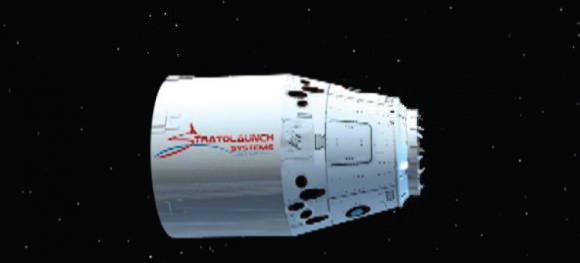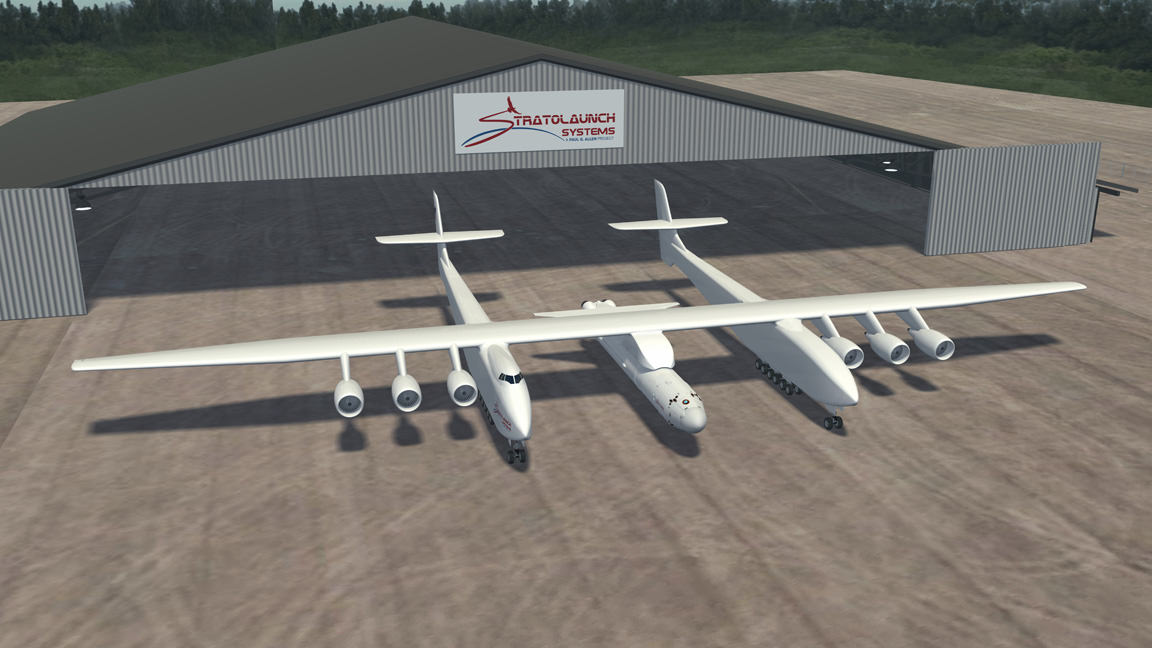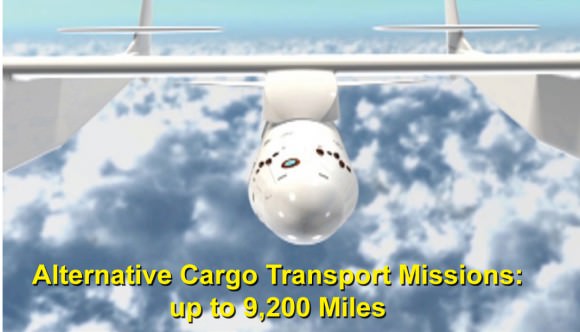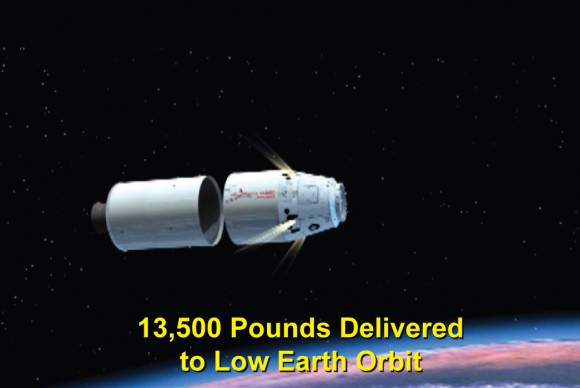[/caption]
A mega quartet of luminaries led by Microsoft co-founder Paul G. Allen and legendary aerospace designer Burt Rutan have joined forces to create a revolutionary new approach to space travel. This new privately funded venture entails the development of a mammoth air-launched space transportation system that aims to dramatically cut the high costs and risks of launching both cargo and human crews to low Earth orbit.
Allen and Rutan are teaming up with Elon Musk, founder of Space Exploration Technologies Corp, or SpaceX, and Michael Griffin, former NASA Administrator, to build the world’s largest aircraft ever flown and use it as a platform to loft a multi-stage SpaceX rocket that will deliver a payload of some 13,500 pounds into earth orbit, about the same class as a Delta II.
Allen and Rutan hope to build upon the spaceflight revolution that they pioneered with the suborbital SpaceShipOne in 2004, which was the first privately funded spaceship to reach the edge of space, and now take the critical next step and actually vault all the way to orbit.
Video Caption: Stratolaunch Systems is pioneering innovative solutions to revolutionize space transportation to orbit.
To accomplish this innovative leap, Allen and Rutan, announced the formation of a new company, funded by Allen, called Stratolaunch Systems at a press briefing today, Dec. 13, held in Seattle, WA. Allen is a billionaire and philanthropist who has funded a host of projects to advance science,
“Our national aspirations for space exploration have been receding,” Allen lamented at the start of the briefing. “This year saw the end of NASA’s space shuttle program. Constellation, which would have taken us back to the moon, has been mothballed as well. For the first time since John Glenn, America cannot fly its own astronauts into space.”
“With government funded spaceflight diminishing, there’s a much expanded opportunity for privately funded efforts.”
Rutan said that Stratolaunch will build a 1.2 million pound carrier aircraft sporting a wingspan of 385 feet – longer than a football field – and which will be powered by six 747 engines on takeoff. The carrier will be a twin fuselage vehicle, like the WhiteKnight developed by Rutan to launch SpaceShipOne.

The 120 foot long SpaceX rocket, weighing up to 490,000 pounds, will be slung in between and dropped at an altitude of about 30,000 feet for the remaining ascent to orbit.
SpaceX will construct a shorter, less powerful version of the firms existing Falcon 9 rocket, which may be either a Falcon 4 or Falcon 5 depending on specifications.
The new launch system will operate from a large airport or spaceport like the Kennedy Space Center, require a 12,000 feet long runway for takeoff and landing and be capable of flying up to 1,300 nautical miles to the payload’s launch point. Crews aboard the huge carrier aircraft will also conduct the countdown and firing of the booster and will monitor payload blasting to orbit.
“I have long dreamed about taking the next big step in private space flight after the success of SpaceShipOne – to offer a flexible, orbital space delivery system,” Allen said. “We are at the dawn of radical change in the space launch industry. Stratolaunch Systems is pioneering an innovative solution that will revolutionize space travel.”
The goal of Stratolaunch is to “bring airport-like operations to the launch of commercial and government payloads and, eventually, human missions,” according to a company statement.
Plans call for a first orbital flight within five years by around 2016. Test flights could begin around 2015.
“We believe this technology has the potential to someday make spaceflight routine by removing many of the constraints associated with ground launched rockets,” said Mike Griffin. “Our system will also provide the flexibility to launch from a large variety of locations.”
Mike Griffin added that the venture is aiming for the small to medium class payload market similar to what has been served by the venerable Delta II rocket, which is now being retired after decades of service.
“NASA’s science satellites could also be lofted by Stratolaunch.”
“At some point this vehicle could loft a crew of say six people,” Griffin stated.
“This is an exciting day,” concluded Allen.
“Stratolaunch will keep America at the forefront of space exploration and give tomorrow’s children something to search for in the night sky and dream about. Work has already started on our project at the Mojave Spaceport.”





I already seen this
Sorry, pet peeve…”I seen” is what the little kids on my country run school bus say. The past tense of “see” is “saw”. You don’t ride a see-seen at the park, do you?
Or bear with him/her if his/her English isn’t up to scratch — the same way I bear with Americans if there units (pound, mile, etc.) aren’t up to international standard 😉
I always think its funny that the people who don’t want you to criticize are criticizing themselves!
P.S. Just for fun…it’s “their”, not “there”. (:
BTW, I’m not American.
Dont’ worry … i think the original person in this thread was.
You should realize, that “don’t want … to criticize” is not what I did, but just to “bear with”, i.e. “being patient or tolerant with”. So, you missed the point and distorted my words.
Regarding the mistake in writing — “there” instead of “their” –, I’m soooo sorry. Bear with me, please 😉
I’m seeing Delta II launch costs of between 32-50 million. With planes, a common passenger plane equation is at http://askville.amazon.com/cost-airline-fly-commercial-jet-York-Los-Angeles/AnswerViewer.do?requestId=2593308 suggests an operating cost of 1.7 to 2.5 times the direct cost. A 747-8 costs $333 million. Soooo… I’m sure the costs of this thing are going to be greater all around. Seems tough to justify.
Good point, maybe that ballast fuselage could carry passengers – I’d be willing to pay good money just to watch that booster being dropped and fired up at 30,000 feet.
Unless its a military payload.
I doubt that equation has much relevance here. Passenger jets spend almost all their time either in the air or preparing for their next flight. This would probably spend most of its time in storage waiting for the next rocket to be delivered.
Thank God for the likes of Rutan, Musk, Bigelow, Allen and Carmack. They realise that our future depends on space-going capability. The key factor is the flexibility which will prevent delayed launches and provide a dependable supply line to LEO. It’s a pity Hubble weighs 24,500 pounds.
As for the aircraft itself, Rutan has said that there are already quite a number of detailed drawings and that it is closer to being built than one would think. An important first step of course is to build that hangar to accommodate this monster of a plane.
I wonder if this system actually is more cost-effective than a straight-up launch. You get a delta V benefit of something like 4% or 5% and an altitude bonus of 10km for an orbit of something like 200km (about 400km for the ISS). Is that worth the added efforts of flying the booster up in a plane? I haven’t crunched the numbers of course and I’m sure these guys know what they’re doing. But I still have a little reservation. You also have this added system complexity; besides handling and operating the booster, you have all the aircraft operations to consider. But hey, if it works out, then that’s great! Anything to lower these pesky launch costs.
Just a minor typo I noticed: In the caption of the first image, it should read “500,000 lb multistage..”
At first glance is would seem to not be worth it but this is where the requirement of carrying all of the mass for launch comes in to play. The specific impulse of an air breathing engine burning Kerosene is very high, several times that of a liquid hydrogen oxygen buring engine. So using this technology in an inexpensive reusable platform such as an aircraft makes sense. The jet engines do the work that the rocket engines would do up to about 500 mph. The altitude savings are not as important but they still add up. A rocket burns a lot more fuel to get to mach .8 then you might think. To offload this fuel and oxidizer to the aircraft greatly reduces the launch weight of the rocket. This is why Space X can go from requiring a Falcon 9 to a Falcon 5 or even 4 with only half the engines, again more savings in mass.
While launching from a plane makes a lot of sense for the small sub-orbitals like virgin galactic is working on, it generally hasn’t made much sense for actual orbital launches. This is because, as you pointed out, the velocity contribution of the plane is relatively small and the vast majority of the energy for orbital launches goes into achieving orbital velocity, not getting into space. It helps a little to start above the thickest parts of the atmosphere, but the bigger the rocket the less that matters. However, from the NY times article http://www.nytimes.com/2011/12/14/science/space/paul-allens-plan-airplanes-as-launching-pads-for-rockets.html?pagewanted=1&_r=1&hp it seems that the real cost savings seem to lie in the flexibility of the launch system and the absence of a launch pad and the related infrastructure. I would be surprised if that was actually more expensive than developing and operating this huge plane but I’m guessing that Paul Allen understands the business side of this better than I do.
i like the use of off the shelf 747 engines.
13,500 lbs. could enable lots of things. think modular.
nice animation but why isn’t the hangar roof covered in PV panels?
This smells like Howard Hughes “Spruce Goose” fiasco from the past… 1) Has Paul Allen filed recently to change his name, and 2) Has he sent out his ‘handlers’ to rent the top floor of a Las Vegas hotel yet??
Old concept finally coming to fruition. You have to think that the airframe of this plane is going to be immensely more reinforced than any other current airframe out there, just to support the weight of that rocket. Still, the practicality of being able to fly above a bad storm and launch, or fire off your rocket well off shore so as to not endanger local populations with potential accidents makes a lot of sense. So too does the idea that if this concept were being used for manned missions, and if the SRB was to fail AFTER being dropped, it would be a lot easier to design a practical emergency system for an object falling straight down rather than propelling itself through the sky at several times the speed of sound. All in all, IF it can be done cost effectively, it makes space travel a lot more achievable.
Spruce Geeses!
But “any orbit, any time”, I like that.
YES! I’ve liked this concept since the X-15 days and now, FINALLY someone’s making that dream come true… THANK YOU Paul Allen and Burt Ratan (newly retired?)! SWEET!
SciFi short story: I work at a spaceport. Most spaceports were attached to existing commercial airports back in the early twenty-teens. By then space flight had became routine. Modern spaceports include many of the old SAC bases, Edwards AFB, White Sands and as extensions to most of the larger Int’l airports, worldwide.
Finding ample water on the moon went a long way into opening up space travel. Now days there are regular flights to the Moon to pick up pure water ice, The ice is sometimes used for radiation shielding on long duration missions. Where toward the end of the mission it is electrolyzed into hydrogen and oxygen gas for fuel and air. Good for the Earth/Mars transfer orbits.
My goal is to work overtime for a couple years so I can pay for a vacation to one of the huge Lunar Ice Palaces. Ice Palaces orbit the moon and have become a major tourist attraction in recent years. Scientists and citizens alike go there to live inside the pressurized ice sculptures. The pure water ice can be shaped with lasers into gigantic optical lens configurations in every suite!
I’m SO excited! I can hardly wait! I’ve been leaning on requesting either the 20 meter Newt or the 10 meter binocular configuration for my stay? I don’t know which one yet… but whichever one I choose will be the one which finds an Earth-like/habitable planet and I’ll win that ‘X’ prize!
Just as a side. Last night I went to the bar in the spaceport after work and had a ‘Lunar Blaster’. It was definitely a splurge doing this because, they are RATHER expensive (50 Euros plus tip). I don’t know if what they say is true? But there’s something about billion year old ice cubes mixed with good Scotch that is unforgettable… for my wallet?
But, Aquaman, the Euro collapsed in 2012. You must have meant dollars, hopefully not yuans. LOL! Good short story!